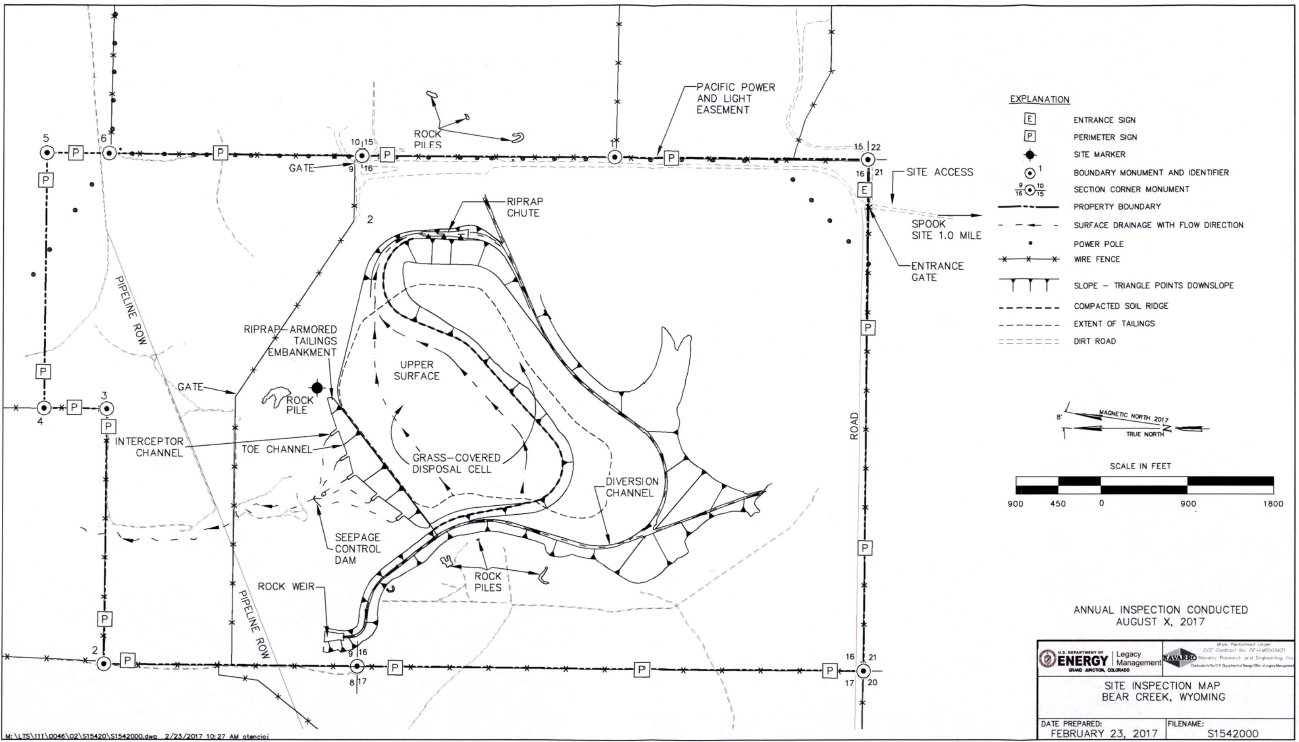Bear Creek
1.0 General Site Information
| Site Location: | Converse County, WY | |
| Former NRC License No.: | SUA-1310 | |
| NRC Docket No.: | 40-8452 | |
| Agreement State Contact: | Omar Nusair | 307-777-7057 |
| NRC Agreement State Site Monitor: | Duncan White | Duncan.White@nrc.gov |
| NRC Site Monitor: | Ronald Burrows | Ronald.Burrows@nrc.gov |
2.0 Site Description
The Bear Creek disposal site is located in rural Converse County, approximately 45 miles northeast of Casper and about 3 7 miles north-northwest of Douglas, Wyoming. The nearest sizeable town is Glenrock, about 29 miles south-southwest of the site. The UMTRCA Title I Spook, Wyoming, Disposal Site is approximately 1 mile south of the Bear Creek site. The federal government owns 977 acres of fee land and has jurisdiction over 25 acres of federal land that comprises the 1002-acre Bear Creek disposal site property. Access to the disposal site is provided by non-exclusive road easements granted by adjacent property owners. The site was transferred from Bear Creek Uranium Company (BCUC) to DOE on November 4, 2009.
3.0 Site History
The Bear Creek uranium mill was owned and operated by BCUC, which was a joint venture of Rocky Mountain Energy, the operating partner, and Southern California Edison. Company reorganization incorporated Rocky Mountain Energy into Union Pacific Resources (UPR). Anadarko Petroleum Corporation (APC) acquired UPR in 2000. Milling commenced in September 1977 and continued until January 20, 1986. The mill processed ore from the Bear Creek uranium mine, which consisted of five open pits near the mill. Ore in these pits was mined mostly from the Wasatch Formation at depths of 100 to 200 ft below the surface. The milling processes incorporated sulfuric acid leaching, sodium chlorate oxidant, liquid ion-exchange, solvent extraction and concentration, drying, and packaging. This process resulted in a tailings solution with a total dissolved solids concentration of approximately 20,000 milligrams per liter and a pH of 1.5 to 2.5 (UPR 1997).
The primary constituents in the tailings solution were chloride and sulfate as well as trace metals from the ore. As a result of these operations, approximately 4.7 million tons of tailings were produced and discharged as a slurry into an adjacent above-grade tailings basin (UPR 1997). The mill and mill buildings were dismantled in 1988 and the tailings were reclaimed in place. All tailings and other contaminated materials were encapsulated in a 101-acre impoundment. The disposal site lies within an ephemeral drainage known as Lang Draw. Another ephemeral drainage referred to as the Northern Flow Path branches off from Lang Draw in the northern portion of the site. The tailings basin was installed in 1977 in Lang Draw and consisted of a zone-fill dam and a compacted soil-lined basin. Although state-of-the-art dam and liner construction techniques were used, BCUC anticipated that some seepage would occur and constructed a seepage catchment-structure below (downgradient of) the tailings embankment to intercept the seepage and pump it back to the tailings basin. Surface seepage was first observed in 1978. Several wells were installed to determine groundwater.
After 1986, an interim cover and three evaporation ponds were constructed on top of the tailings area. The evaporation ponds were part of a groundwater corrective action program that resulted in the evaporation of some 477 million gallons of water from within the disposal cell and the area below the embankment. The program ceased when lowered water levels in the cell, the area below the embankment, and in the recovery wells rendered it ineffective. The mill and adjacent solvent extraction buildings were decommissioned in 1988.
NRC concurred with the reclamation plan in 1984 .and with modifications to the plan in 1986. Following the 10-year commitment to perform groundwater corrective action, BCUC closed the tailings impoundment in December 1999. NRC concurred that the reclamation plan was implemented in 2001. NRC documented acceptance of the application for ACLs in 1997 but requested a subsequent revision of the ACLs after monitoring results showed that a point-of-exposure (POE) well had concentrations exceeding model predictions. NRC subsequently approved a revised ACL application and associated license amendment in 2013. In December 2019 the Wyoming Department of Environmental Quality, Land Quality Division (WDEQ/LQD) informed the licensee that all wells at the site could be abandoned and plugged.

Long-Term Surveillance Plan for the Bear Creek, Wyoming (UMTRCA Title II) Disposal Site, Converse County, Wyoming LMS/BRC/S00712-1.0, March 2017
4.0 Current NRC actions/status
The NRC is awaiting the WDEQ/LDQ’s submission of the Completion Review Report.
5.0 Expected Transition to DOE for LTS&M
2024 (See DOE LM Site Management Guide, June 2022)
Page Last Reviewed/Updated Friday, October 28, 2022
Page Last Reviewed/Updated Friday, October 28, 2022

